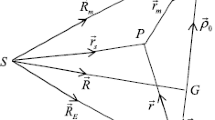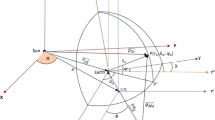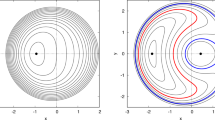Abstract
We have investigated the resonances in the earth-moon system around the sun including earth’s equatorial ellipticity. The resonance resulting from the commensurability between the mean motion of the moon and Γ (angle measured from the minor axis of the earth’s equatorial ellipse to the projection of the moon on the plane of the equator) is analyzed. The amplitude and the time period of the oscillation have been determined by using the procedure of Brown and Shook. We have shown the effects of Γ on the amplitude and the time period of the resonance oscillation using the data of the moon. It is observed that the amplitude decreases and the time period also decreases as Γ increases from 0∘ to 45∘.







Similar content being viewed by others
References
Abd EI-Salam, F.A., Abdel-Aziz, Y.A., EI-Saftawy, M., Radwan, M.: Analysis of lunisolar resonances in an artificial satellite orbits. Appl. Math. Sci. 2(21), 1013–1021 (2008)
Bhatnagar, K.B., Mehra, M.: The motion of a geosynchronous satellite-I. Indian J. Pure Appl. Math. 17(12), 1438–1452 (1986)
Breiter, S.: Lunisolar apsidal resonances at low satellite orbits. Celest. Mech. Dyn. Astron. 74, 253–274 (1999)
Breiter, S.: The prograde C7 resonance for Earth and Mars satellite orbits. Celest. Mech. Dyn. Astron. 77, 201–214 (2000)
Breiter, S.: On the coupling of lunisolar resonances for Earth satellite orbits. Celest. Mech. Dyn. Astron. 80, 1–20 (2001)
Brown, E.W., Shook, C.A.: Planetary Theory. Cambridge University Press, Cambridge (1933)
Cook, G.E.: Luni-solar perturbations of the orbit of an Earth satellite. Geophys. J. R. Astron. Soc. 6(3), 271–291 (1962)
Hughes, S.: Earth satellite orbits with resonant lunisolar perturbations. 1. Resonances dependent only on inclination. Proc. R. Soc. Lond. Ser. A 372, 243–264 (1980)
Radwan, M.: Résonance caused by the Luni-Solar Attractions on a Satellite of the Oblate Earth. Astrophys. Space Sci. 282, 551–562 (2002)
Yadav, S., Aggarwal, R.: Resonance in a geo-centric satellite due to Earth’s equatorial ellipticity. Astrophys. Space Sci. (2013). doi:10.1007/s10509-013-1515-1
Acknowledgement
We are thankful to the Centre for Fundamental Research in Space Dynamics and Celestial Mechanics (CFRSC) for providing all facilities for this research work.
Author information
Authors and Affiliations
Corresponding author
Appendices
Appendix A
Appendix B
Appendix C
Rights and permissions
About this article
Cite this article
Yadav, S., Aggarwal, R. Resonance in the earth-moon system around the sun including earth’s equatorial ellipticity. Astrophys Space Sci 348, 367–375 (2013). https://doi.org/10.1007/s10509-013-1587-y
Received:
Accepted:
Published:
Issue Date:
DOI: https://doi.org/10.1007/s10509-013-1587-y




